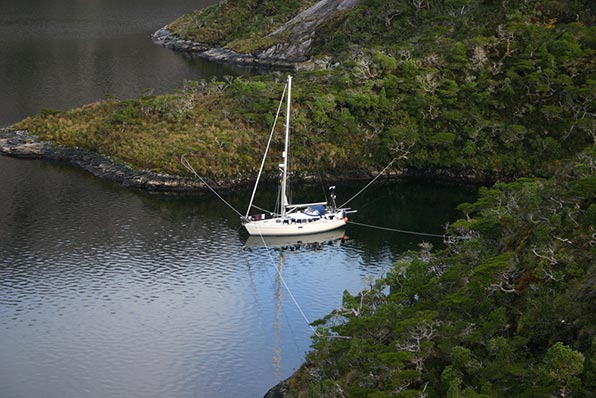An intro to Williwaws
While my last post related to sailing in heavy weather, from what I’ve read, in the Patagonia region, strong katabatic winds known as williwaws are a threat to anchored vessels too.
“In the Fuegian Archipelago (or Tierra del Fuego) in South America as well as in Alaska, a wind known as a williwaw is a particular danger to harboring vessels. Williwaws originate in the snow and ice fields of the coastal mountains, and they can feature winds stronger than 120 knots (140 mph; 220 km/h).” Source
These challenging conditions are no doubt at least one reason why it is common to shore tie the boat with several long lines after anchoring in the Chilean Canals. While we have run lines to shore a few times before to limit swinging, a process described quite well by our friends Livia and Carol, we have not had to contend with anything close to the conditions described above.

Some boats, like the one linked above, have specially designed reels to pay out the long lines. Others use much less expensive floating polypropylene line flaked into bags that they pay out from the dinghy. Still, others have one or more of these. As with anything new, we’ll have to come up with a system for this.


A few things to realize about reels. Line is always subject UV radiation and you should renew it rather frequently. Another thing is that line has very little friction, you can throw rope around cleat and easily hold rope on your hands without problems but line can cut your fingers.
I have cleated webbing before and it seemed to hold quite well. I also never found my fingers were at risk of being cut. Perhaps you’re used to other material. It also seems to me like the reel would limit to UV exposure to all but the most outer loop.
This is a way of life in BC waters. It was told to us many years ago, if you can sail in BC waters you can sail anywhere in the world. We have it all here.
We have used the hose hangers containing many metres of rope, and bags filled with rope. The hose hanger works the best.
It’s funny how many times I have heard that about different locations… If you can sail in XYZ (Lake Ontario, Lake Michigan, etc.). 🙂
I do believe the West Coast of Canada would present a number of challenges though.
If I am reading correctly, the williwaw is a wind that descends from the mountains down to the sea. Wouldn’t the boat pictured in your post be in a dangerous orientation for a 120 knot wind from the land? I would think you would want your bow pointed towards the expected wind to preserve canvas and shield the cockpit from the worst of it.
I believe that boat is pretty much surrounded by land, at least on three sides. I also suspect that the primary wind is coming from the bow and thus the boat needs to be set that way to lie properly on its anchor.
The thought of those winds does strike a little fear in my heart! I just heard a 59 degrees North Sailing podcast with guest Matt Rutherford talking about them and anchoring. A tip (or clue) he shared was to notice if the surrounding rocks had moss on them or if they looked windswept and bare.
Or trees growing parallel to the ground. 🙂
Hi Mike – sent you a DM on FB but it may be in your ‘other’ folder. Of course you may just be busy but thought I’d mention it in case it got lost somewhere. Sarah
Got it. Yes, just busy. I just replied though. 🙂